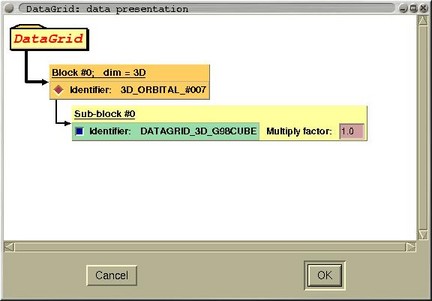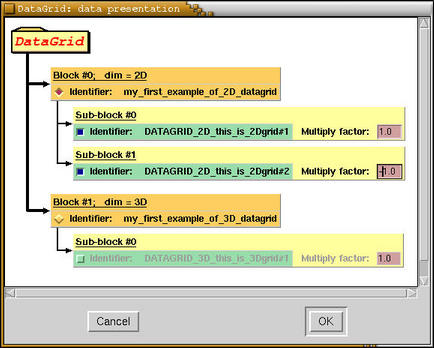XCrySDen can display
properties such as charge densities, molecular orbitals, or any
other 2D or 3D scalar field as isosurface or contours. This means,
that a uniform 2D or 3D grid of points (containing the field
values)---the grid does not need to be orthogonal---should be
provided. Such grids are called
Data Grids by
XCrySDen. In order to display the
isosurfaces/contours, the scalar field data should be written in
XSF format.
Here you can find
the corresponding XSF description. The users of CRYSTAL and WIEN
programs can achieve such plots also using the
XCrySDen's interface for
CRYSTAL and
WIEN.
Once the XSF file is constructed, one should load it either as
xcrysden --xsf my_file.xsf or via the
File-->Open Structure ...-->Open
XSF(Xcrysden Structure File) menu. Then proceed via
the Tools-->Data Grid
menu. The following window will appear:

This window plots schematically the structure of the scalar fields
inputs. Namely, XSF file can contain several scalar fields. In the
above example (i.e. figure of the window) the file contains only
one scalar field. here is an example of window that corresponds to
the file that contains several scalar fields:

In this example, three scalar fields are specified (see the three
yellow-green rectangles, designated as sub-blocks). The first two
are two-dimensional, and are mutual compatible, therefore they are
specified within one block (i.e. block #0 on the figure). The third
scalar field is three-dimensional. Here the user should specify
which scalar field would like to plot. This is achieved by
selecting (i.e. mouse-clicking) one radiobutton on orange
block-rectangles. Then within a block one can select several scalar
fields by mouse-clicking the corresponding checkbuttons on
yellow-green subblock-rectangles. In above example two scalar
fields are selected (see red checkbuttons on yellow-green subblock
rectangles). A weight (i.e. multiply factor) for each selected
scalar fields should be selected. Then the resulting scalar fields
is calculated as:
Fres(r) =
w(1)*F1(r) + w(2)*F2(r) +
...,
where w(i) is the weight (i.e. multiply factor) for i-th selected
scalar field.
Once the scalar fields are selected and the weights are set,
press the [OK] button. Then next window will appear, where
various isosurface or contours parameters can be controlled.
Here you can read how to control the
display of the isosurfaces, and here you can get the description of how to
control the display of contours.

![[Figure]](img/xcrysden-picture-small-new.jpg)

![[Figure]](img/xcrysden-picture-small-new.jpg)